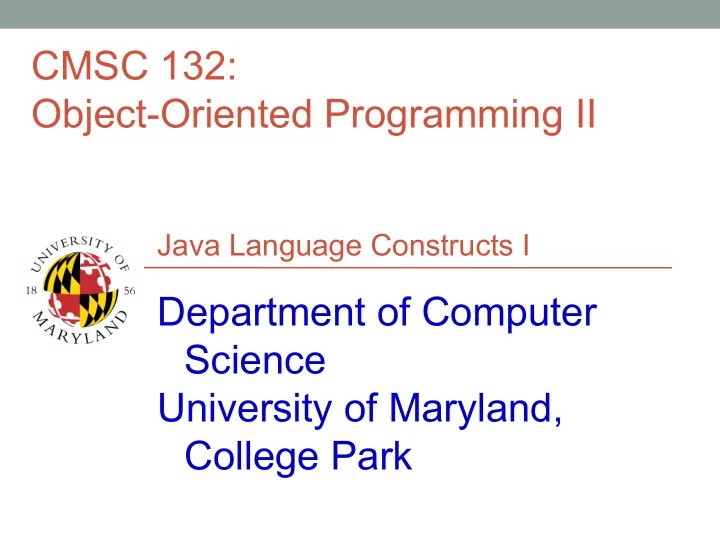

CMSC 132: Object-Oriented Programming II Java Language Constructs I Department of Computer Science University of Maryland, College Park
About Style Questions about style: two good references: ➔ http://www.cs.umd.edu/class/fall2013/cmsc132h/resources.shtml ➔ http://www.cs.umd.edu/class/fall2013/cmsc132h/styleGuidelines.html
Enumerated Types • New type of variable with set of fixed values • Establishes all possible values by listing them • Supports values(), valueOf(), name(), compareTo()… • Can add fields and methods to enums • Example: Color.java • In Eclipse we define them as we defined classes • When to use enums • Natural enumerated types – days of week, phases of the moon, seasons • Sets where you know all possible values • Example: Deck.java
Implementing Equals • Approach we want to use (assuming class A) public boolean equals(Object obj) { if (obj == this) return true; if (!(obj instanceof A)) // covers obj == null case return false; A a = (A)obj; /* Specific comparison based on A fields appears here */ } • What happens if we use comparisons of Class objects rather than instanceof? • Example: equalsMethod package
Comparable Interface • Comparable • public int compareTo(T o) • a.compareTo(b) returns • Negative if a < b, 0 if a == b, positive if a > b • Properties • Referred to as the class's natural ordering • Can sort using Collections.sort( ) & Arrays.sort( ) • Example: Collections.sort(myList); • Can use as keys in SortedMap & SortedSet • Consistency w/ equals( ) strongly recommended • x.equals(y) if and only if x.compareTo(y) == 0
Annotations • Annotation – Provides data about a program with not direct effect on the operation of the code they annotate • Uses • Information for the compiler (e.g., suppress warnings) • Compiler/Deployment time processing • Tools can process annotations in order to generate code • Runtime • Some are available to be examined at runtime. • Validity constraint examples • A instance variable cannot assume a negative value • A parameter can not be null
Annotations • In JUnit4 we use @Test to identify an annotation • Syntax at-sign (@) followed by annotation type and a parenthesized list of element-value pairs (no parentheses needed if not elements are present) • Annotations used by the compiler • @Deprecated – Element is deprecated and should no longer be used • @Override – Informs compiler element is meant to override an element. If the method does not correctly override a method, a compiler error will be generated • @SuppressWarnings – Informs the compiler to suppress specific warnings • Reference • http://docs.oracle.com/javase/tutorial/java/javaOO/annotations.html
Recommend
More recommend